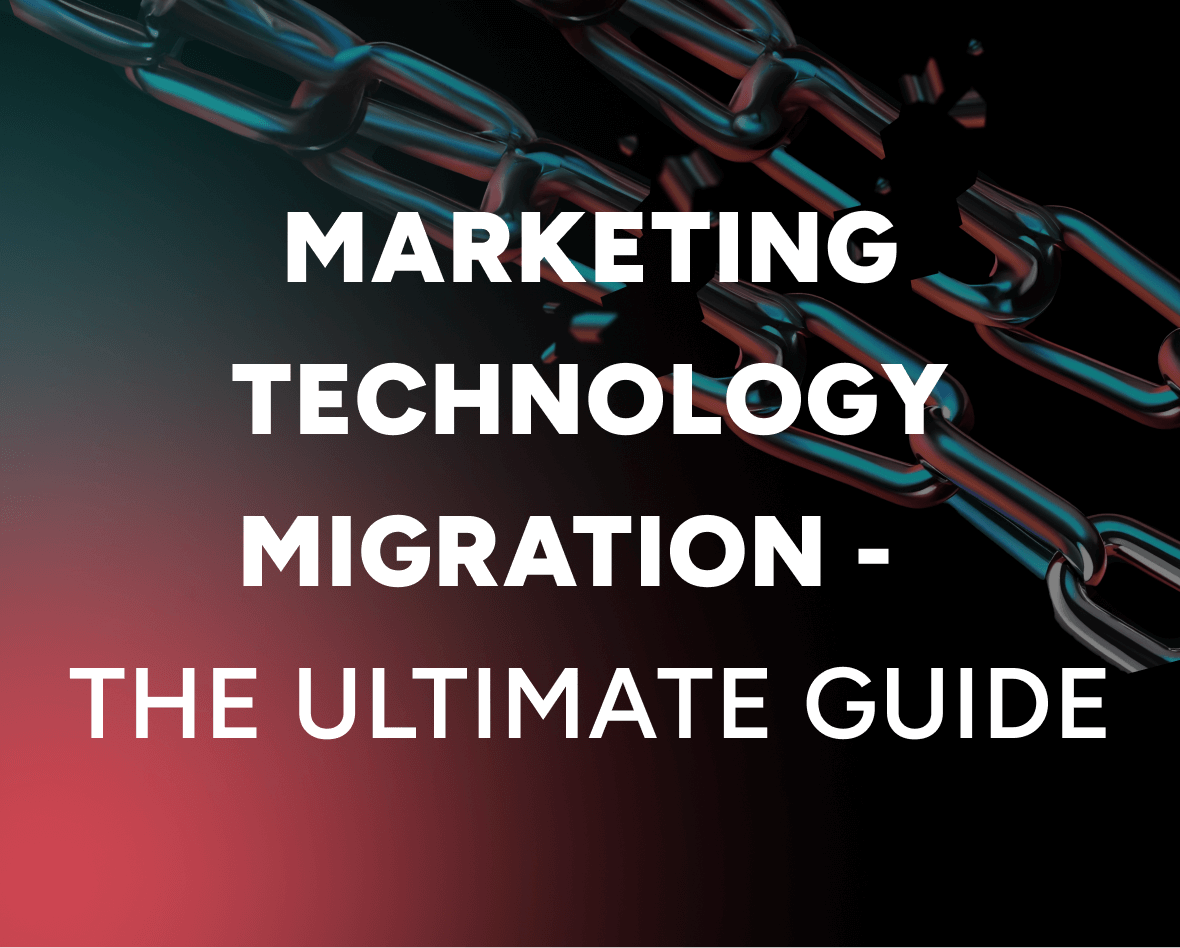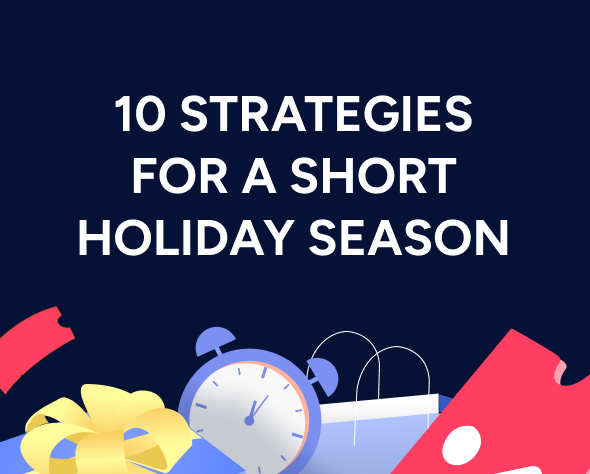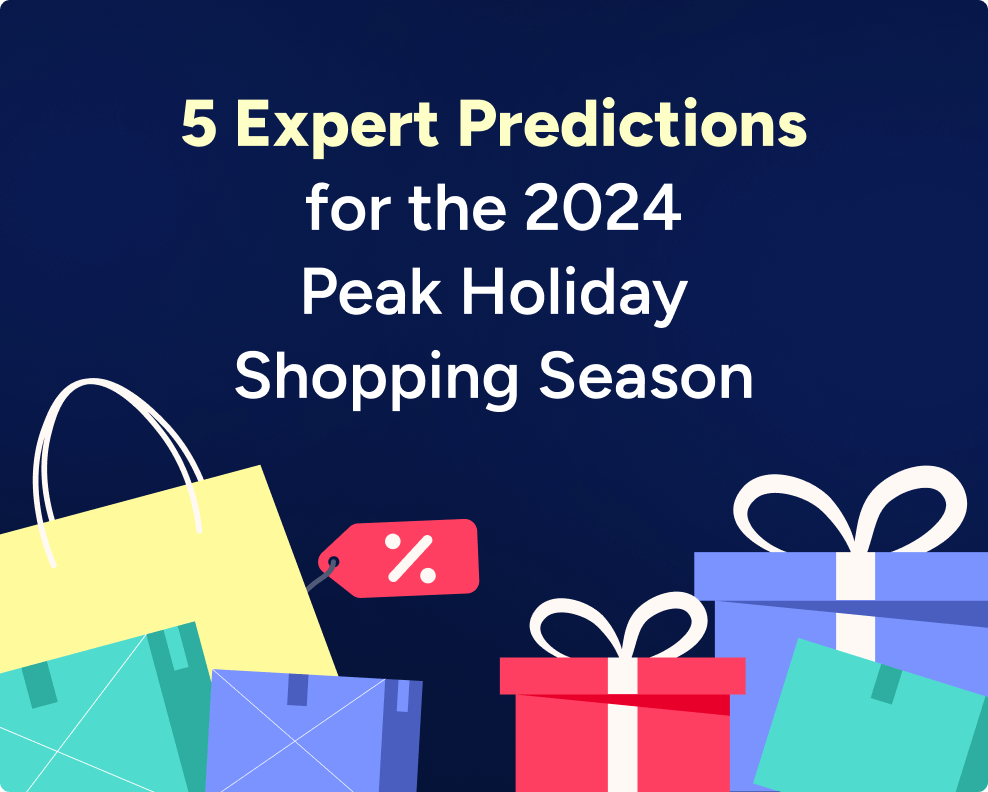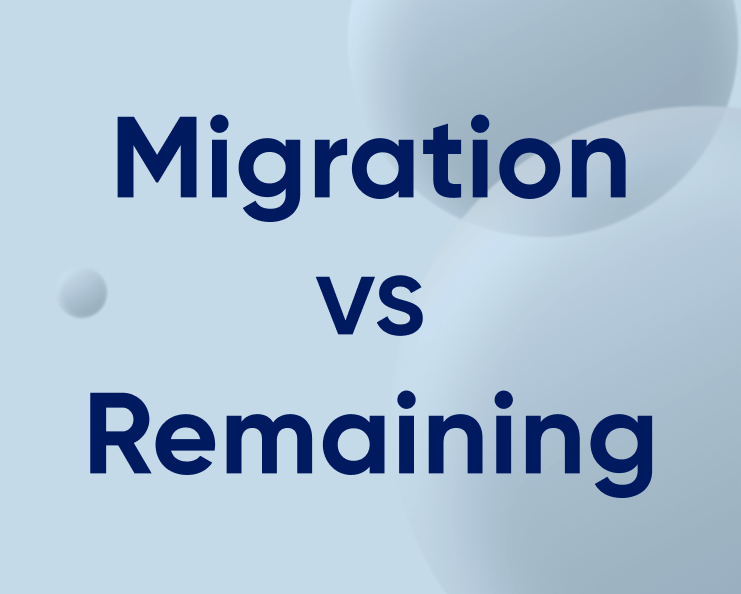First-party data for enriched, responsible marketing
We are surrounded by extreme individualization today. And consumers have come to expect this same level of personalization and relevancy from companies of all sizes. If you don’t deliver, users churn. In fact, 52% of customers reported that they bought more from a business that delivered a more delightful user experience.
Investing in personalization to build relationships and create better consumer experiences goes a long way for brands. For this, companies need to know every little detail of their customers – their purchase history, product preferences, and affinity to discounts.
Updated on Sep 29, 2020
Companies usually leverage third-party data sources to gain access to this user information. They partner with other businesses, invest millions in purchasing consumer data, to create targeted marketing strategies. Using 3rd party data works when your goal is customer acquisition.
But how do marketers access information on existing customers? By using first-party data. This is the data that comes from a company’s in-house sources, such as websites, apps, CRM, social media, or surveys. According to eMarketer, 85% of US marketers and 75% of European respondents said that using first-party data was a priority for them.
Know Your Customer Data Types
It’s not what data you collect, but where you get it from, that matters the most. Understanding the difference between data types – zero, first, second, and third – is crucial for building the right strategy to keep your customer data secure and your users happy. First and third-party data are the most commonly discussed data types. But with the data landscape changing for marketers, 3rd party cookies turning obsolete and Apple’s IDFA opt-outs, it is critical to understand zero-party data as well. (Refer to the chart “A Comparative Guide to Data Types”)
Defining zero-party data, Forrester Analyst Stepanie Liu said: “This is data that a customer intentionally and proactively shares with a brand. This can include preference center data, purchase intentions, personal context, and how an individual wants the brand to recognize her.” When a first-party data strategy doesn’t work for businesses, they need to be able to move to collect zero-party data.
Third-party data is the most easily available data, and therefore, formed the bulk of data that markets and analysts worked with. But with the growing importance of data governing bodies, privacy regulations, and the market’s need for delivering personalized user experiences, first-party data is fast replacing third-party data on the marketer’s pedestal.
What is a First-Party Data?
First-party data is the information collected directly from your customers, website visitors, mobile app users, or email database list based on how they interact with your business, product, or service. These are users who have engaged directly with your business. Hence, it is considered high-quality, highly relevant, and cost-effective. Companies are also the primary owner of this data. Second-party and third-party data, on the other hand, come from outside sources.
Let’s simplify first-party data, using an example. Let’s consider that a user visits your e-commerce website to buy a pair of running shoes. Before he makes the purchase, you ask him to either create a personal account or continue as a guest. The user fills a form and shares information, including his name, email id, and location. Once the purchase is completed, the information on the shoes he bought, its brand, color, and size is also added to his data profile. All these details that a customer shares willingly with a retailer become your first-party data.
What is Third-Party Data?
Third-party data is the data on user behavior that companies purchase from other businesses. It is collected and consolidated from various websites and usually segmented based on user demographics, shopping behavior, and interests. The exchange of this data doesn’t have the consent of the customer and is usually shared across multiple businesses without the customer’s permission.
Let’s consider an example. A customer applies for a housing loan with a bank and shares his personal details, his name, job title, name of the company that he works for, income, and contact address. If the bank were to sell this information to your business, then you would be purchasing third-party data. While the customer willingly provided this information to the bank, he did not give the consent to it being shared.
First-Party Data Vs Third-Party Data
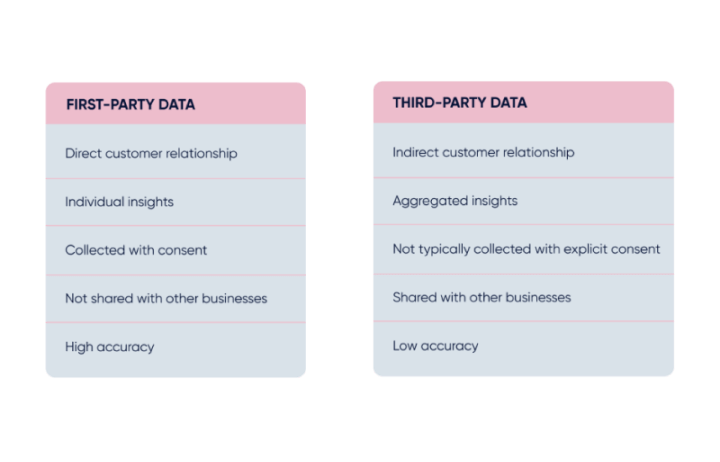
Here’s a comparative guide to help you understand and compare data types:
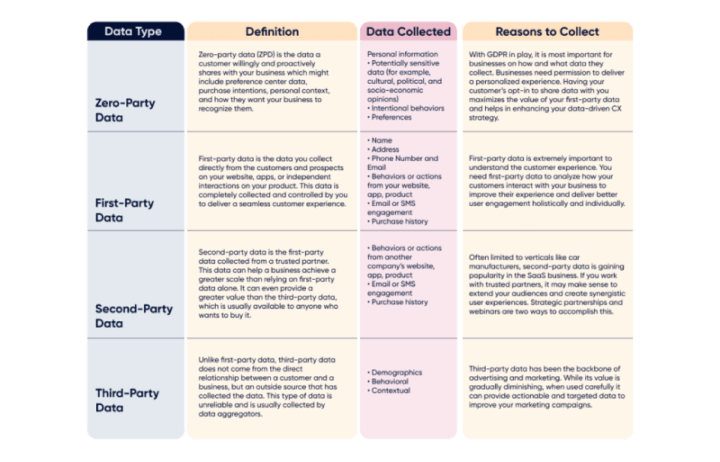
Importance of First-Party Data
- High relevance – First-party data holds higher relevance when compared to other data types
- High accuracy – Since this data is directly collected from your customers, it is highly accurate than the 3rd party data
- Ease of collection – First-party data is easy to collect and manage especially if you are using a customer data platform
- Cost-effective – unlike third-party data, first-party data is collected at zero cost.
- Data Compliance – Complies with data privacy laws
Reasons to Adopt a First-Party Data Strategy
Today, businesses have to comply with two essential consumer requirements:
- A need to provide privacy and transparency.
- Provide personalized engagement and enhanced user experience.
To navigate these factors, businesses need to adopt first-party data-dependent strategies. Also, with the huge leaps in prioritizing privacy in browser usage, consumers have more control over the data that they share with a business. This also reinforces the growing importance of first-party data. Here’s why businesses should adopt first-party data-dependent strategies at the earliest:
- Web Browser Changes
The web browsing experience has undergone transformational changes. Policies around browser cookies are being constantly upgraded, which means that online marketing strategies have to keep pace with them. In early 2020, Google launched SameSite cookies on its Chrome browser to improve privacy and give users more control over the data they shared. With this feature, Google came on the same page as Apple and Mozilla’s privacy settings.
A website creates cookies to collect information on its visitors. These are known as first-party cookies and the website is its sole owner. All other cookies can be clubbed in the third-party category and are mostly used by advertising networks to improve their advertisements and target them to the right audience.
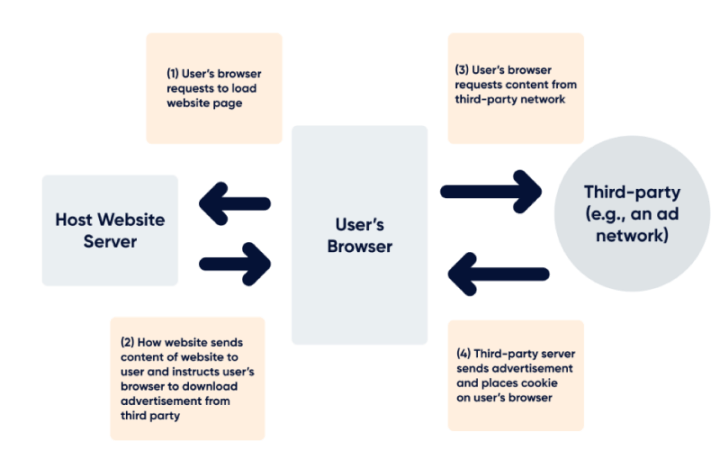
Marketers have usually been dependent on third-party cookies to target their ads. But with the recent changes in browser usage, they no longer remain the best option, while looking for customer information. Adopting a first-party data strategy is a more efficient method for marketers to make their ads hyper-relevant and increase conversions.
- Data Privacy Laws
Data privacy is all about transparency. Marketers let their customers know what data they collect from them and what they do with it. Data privacy is a great way to win a customer’s trust.
Data privacy essentially has two essential levers:
- How the data is collected, where it is stored, and how it flows through an organization.
- What data a company collects, when, and why.
Companies inform their consumers about these details in order to give them a clear picture of what data they’re collecting and how they will use it.
While data privacy is one way to assure customers about the safety of their data, GDPR takes it to the next level. With GDPR, businesses need to prove that they collect data ethically. This becomes easy if companies use first-party data. But complications arise in using second and third-party data.
If your business is committed to delivering a seamless user experience, you need to follow the best practices of data privacy. Collecting first-party data will make a significant difference in improving consumer trust in your data privacy practices.
- Personalization without third-party data
With all the hurdles in collecting third-party data, first-party data should become a priority for businesses to deliver a personalized user experience. This is the data that companies own, control, and can use in any way, to improve personalization and enhance user experience journeys.
First-party data includes web analytics data, behavioral data (e.g. purchase history), data from CRM tools, and any data that customers share. A company’s Customer Data Platform (CDP) is the best place to integrate all this data and create a comprehensive user profile that can be leveraged to personalize customer experiences.
First-party data can be used in innumerable ways. How much data you have isn’t important anymore, it’s what you do with it.
Here are a few ways to use first-party data for marketing and advertising:
- Use web analytics data to improve poor performing content and pages.
- Send targeted and triggered emails to customers based on their recent website activity.
- Segment your customer base to improve targeting and personalization.
- Use a multi-channel marketing automation platform to engage users across all channels that they are present on.
- Improve the consistency of messaging across channels to make it seamless for customers.
A First-Party Data Limbo for Data-driven Marketers
Marketers can face several challenges as they maximize the value of their data, especially first-party data:
- No data strategy in place – How do you identify all your data sources and what data points across a customer journey are you collecting and mapping them from?
- Connecting data across channels – How do you put all the data collected from the web, mobile apps, CRM, email, point-of-sale, beacons together, to create a complete picture of your customer?
- Unifying data and identity – How do you link fragmented data to build unified customer profiles and create a comprehensive view of each customer?
- Taking action in real-time – How do you take advantage of your customer’s interests and behaviors?
How To Get Started With Your First-Party Data Strategy
Here’s a step-by-step guide to create and leverage your first-party data strategy:
- Decide on what data to collect
First-party data can be a business’s lifeblood, as marketers own all rights to this information. However, adhering to privacy and governing laws and ensuring transparency is critical. Doing so builds trust and a long-term relationship with your customer.
FIrst-party data includes:
- Data from consumer behavior or actions taken across a website, app, and/or product
- Data from CRM
- Data from lead collection forms across all channels
- Data from social media advertising and engagement
- Data from subscription-based emails or products
- Data from polls, surveys
- Data from customer feedback
Based on a company’s objective, marketers need to decide on the type of data to collect and the data points to store.
2. How to collect data
Businesses collect first-party data via website Google Analytics, mobile apps, social media, surveys, email, SMS, beacons, CRM systems, customer service interactions, point of purchase, and direct mail (using digital data to inform your offline campaigns).
It’s likely that you’ve already checked some or all of these channels. But don’t just stop there. Tap into the analysis of customer interactions on your website or app. This could reveal more creative first-party data collection opportunities. Just remember, you still need to offer value in return for data.
Leverage contextual pools and surveys, feedback forms, gamification of user experiences, purchase patterns and A/B test your creatives to collect more focussed first-party data.
3. Put a CDP in play
CDPs enable businesses to understand customer data and derive insights to enrich customer experience. Insider’s AI-powered Customer Data Platform has been instrumental in driving millions of dollars’ worth of incremental leads and revenue for the world’s leading businesses.
CDP has two main purposes:
- To unify your first-party (and even third-party) customer data.
- To activate the data collected through your marketing channels, advertising networks, tools, etc.
Once you have your customer data in the CDP, you can use it through different methods, like segmentation, to activate it across your marketing and advertising channels.
Once your customers engage on these channels, that data is sent back into the CDP to further build and enrich user profiles. This cycle continues to build more robust, accurate, and data-rich user profiles that will lead to more optimized marketing and advertising.
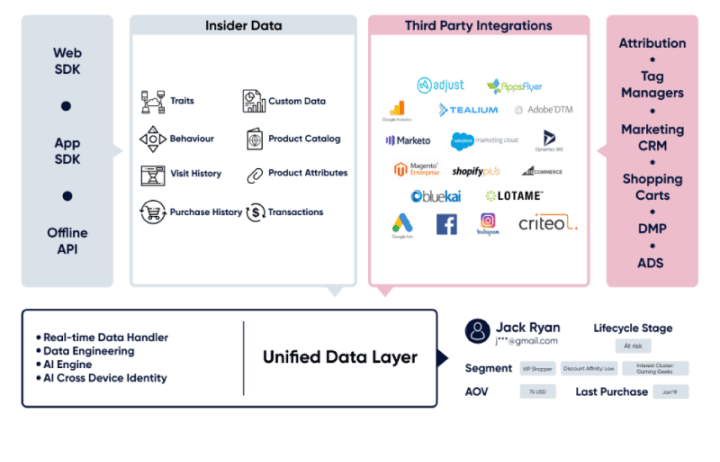
4. Putting Your Data to Use and Activating It
This can be done by:
- Intelligently segmenting your audience
- Bridging offline and online experiences
- Unifying your messaging
- Contextual and informed engagement
- Seamless orchestration
5. Standardize your data for better processing
After you have decided on what first-party data to collect, you need to ensure the data is standardized across the various touchpoints from where it’s collected. This means you will have to establish a single source of truth that clearly defines what data you are collecting, provides a consistent naming convention and ensures the data is collected in a uniform fashion, in order to provide a clear context to marketers on how to interpret the data.
6. Review and clean your data frequently
Having standardized your data collection and naming convention, you need to set up a process to validate the data, to ensure it is consistent, accurate, and usable. Consult your key stakeholders to make sure that the evolution of your tech stack is integrated into your first-party data strategy. Don’t leave out new data sources.
7. Audit your data sources and data flows to comply with data privacy and regulations
Always audit your data sources to identify what data is being collected, to what extent it is used, and how it is measured. Cross-reference your data sources and data points with the data requirements of the marketing and analytics use cases you plan to execute and make sure you collect data that meet your objectives.
As a business, you need to be aware of what data you process and ensure it is done in accordance with the law. As part of an EU General Data Protection Regulation (GDPR) compliance project, you must map your information and data flow so that privacy risks can be easily assessed. Often, companies process more data than they require, so it is vital to implement data flow maps.
A data flow audit is needed to create a data flow map. This audit pinpoints the locations where data is stored, both within and outside a business, and where that data is flowing to and coming from.
Let the (First-Data) Party Begin!
To conclude, whether you’re a healthcare, retail, travel, restaurant, technology, or government firm, consumers expect the same thing: seamless customer experiences personalized to meet their tastes, engagement through multiple channels, and trust that their personal data is in good hands.
With the right customer data technology at the heart of their first-party data strategy, businesses have the ability to adapt to new data sources, feed that data into advanced technology like machine learning, and scale for future growth. That technology— if you haven’t guessed already— is the Customer Data Platform. While it does not stand alone, it is the cornerstone of a customer-centric approach to first-party data collection and usage. It enables personalization efforts while helping companies to meet privacy regulation demands.
Switching to a first-party data strategy won’t happen overnight. But you can unlock the path by investing in Insider’s data-first Customer Data Platform.

